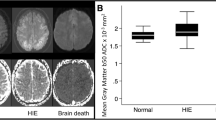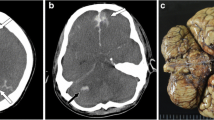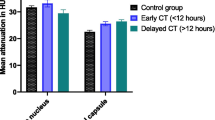Abstract
The purpose of this study was to evaluate the usefulness of brain postmortem computed tomography (PMCT) findings for the detection of global hypoxia or hypoperfusion leading to hypoxic–ischemic encephalopathy (HIE) prior to death. Cadavers of individuals who died from non-traumatic causes were subjected to PMCT and pathological autopsy. Cases with an episode of cardiopulmonary arrest, hypoxia, or hypoperfusion that required intensive respiratory management at least 24 h before death and exhibited findings of HIE in conventional autopsy (HIE group, n = 6) were compared with those without such episodes prior to death (control group; overall, n = 37; age-matched, n = 8) with regard to four parameters: (1) width of the central sulcus (CS), (2) attenuation difference at the basal ganglia (BG) level, (3) attenuation difference between cerebral gray matter (GM) and cerebral white matter (WM), and (4) attenuation difference between cerebellar GM and cerebral GM. The results revealed significant differences in the width of the CS (P < 0.001), attenuation difference at the BG level (P < 0.001), and attenuation difference between cerebral GM and cerebral WM (P = 0.009) between the HIE group and the overall control group. When the age-matched control group and the HIE group were compared, there was a significant difference in the width of the CS (P = 0.026) and attenuation difference at the BG level (P < 0.001). Our results suggest that effacement of the sulcus of the cerebral hemisphere and the loss of contrast at the BG level on brain PMCT indicate the existence of HIE prior to death.



Similar content being viewed by others
References
Bolliger SA, Thali MJ, Ross S, Buck U, Naether S, Vock P. Virtual autopsy using imaging: bridging radiologic and forensic sciences. A review of the Virtopsy and similar projects. Eur Radiol. 2008;18:273–82.
Thali MJ, Yen K, Schweitzer W, Vock P, Boesch C, Ozdoba C, et al. Virtopsy, a new imaging horizon in forensic pathology: virtual autopsy by postmortem multislice computed tomography (MSCT) and magnetic resonance imaging (MRI)—a feasibility study. J Forensic Sci. 2003;48:386–403.
O’Donnell C, Woodford N. Postmortem radiology—a new sub-speciality? Clin Radiol. 2008;63:1189–94.
Roberts IS, Benamore RE, Benbow EW, Lee SH, Harris JN, Jackson A, et al. Postmortem imaging as an alternative to autopsy in the diagnosis of adult deaths: a validation study. Lancet. 2012;379:136–42.
Cha JG, Kim DH, Paik SH, Park JS, Park SJ, Lee HK, et al. Utility of postmortem autopsy via whole-body imaging: initial observations comparing MDCT and 3.0 T MRI findings with autopsy findings. Korean J Radiol. 2010;11:395–406.
Flach PM, Thali MJ, Germerott T. Times have changed! Forensic radiology—a new challenge for radiology and forensic pathology. Am J Roentgenol. 2014;202:W325–34.
Ishida M, Gonoi W, Okuma H, Shirota G, Shintani Y, Abe H, et al. Common postmortem computed tomography findings following atraumatic death: differentiation between normal postmortem changes and pathologic lesions. Korean J Radiol. 2015;16:798–809.
Takahashi N, Satou C, Higuchi T, Shiotani M, Maeda H, Hirose Y. Quantitative analysis of brain edema and swelling on early postmortem computed tomography: comparison with antemortem computed tomography. Jpn J Radiol. 2010;28:349–54.
Shirota G, Gonoi W, Ishida M, Okuma H, Shintani Y, Abe H, et al. Brain swelling and loss of gray and white matter differentiation in human postmortem cases by computed tomography. PLoS ONE. 2015;10:e0143848.
Levy AD, Harcke HT, Mallak CT. Postmortem imaging: MDCT features of postmortem change and decomposition. Am J Forensic Med Pathol. 2010;31:12–7.
Kjos BO, Brant-Zawadzki M, Young RG. Early CT findings of global central nervous system hypoperfusion. Am J Roentgenol. 1983;141:1227–32.
Torbey MT, Selim M, Knorr J, Bigelow C, Recht L. Quantitative analysis of the loss of distinction between gray and white matter in comatose patients after cardiac arrest. Stroke. 2000;31:2163–7.
Smith AB, Lattin GE Jr, Berran P, Harcke HT. Common and expected postmortem CT observations involving the brain: mimics of antemortem pathology. Am J Neuroradiol. 2012;33:1387–91.
Ujihira N, Hashizume Y, Takahashi A. A neuropathological study on respirator brain. Rinsho Shinkeigaku. 1993;33:141–9.
Ujihira N, Hashizume Y, Takahashi A. A clinico-neuropathological study on brain death. Nagoya J Med Sci. 1993;56:89–99.
Yanagawa Y, Un-no Y, Sakamoto T, Okada Y. Cerebral density on CT immediately after a successful resuscitation of cardiopulmonary arrest correlates with outcome. Resuscitation. 2005;64:97–101.
Choi SP, Park HK, Park KN, Kim YM, Ahn KJ, Choi KH, et al. The density ratio of grey to white matter on computed tomography as an early predictor of vegetative state or death after cardiac arrest. Emerg Med J. 2008;25:666–9.
Gutierrez LG, Rovira A, Portela LA, da Costa Leite C, Lucato LT. CT and MR in non-neonatal hypoxic-ischemic encephalopathy: radiological findings with pathophysiological correlations. Neuroradiology. 2010;52:949–76.
Skriver EB, Olsen TS. Transient disappearance of cerebral infarcts on CT scan, the so-called fogging effect. Neuroradiology. 1981;22:61–5.
Chalela JA, Kasner SE. The fogging effect. Neurology. 2000;55:315.
Han BK, Towbin RB, De Courten-Myers G, McLaurin RL, Ball WS Jr. Reversal sign on CT: effect of anoxic/ischemic cerebral injury in children. Am J Roentgenol. 1990;154:361–8.
Dedouit F, Sevely A, Costagliola R, Otal P, Loubes-Lacroix F, Manelfe C, et al. Reversal sign on ante- and postmortem brain imaging in a newborn: report of one case. Forensic Sci Int. 2008;182:e11–4.
Chalela JA, Rothlisberger J, West B, Hays A. The white cerebellum sign: an under recognized sign of increased intracranial pressure. Neurocrit Care. 2013;18:398–9.
Acknowledgments
This work was supported by a grant from the Japanese Ministry of Health, Labor and Welfare, for research into “Usefulness of Postmortem Images as an Ancillary Method for Autopsy in Evaluation of Death Associated with Medical Practice (2008–2009)”. The authors wish to acknowledge Dr Kuni Ohtomo, President, International University of Health and Welfare, for his for his intellectual contribution and proofreading and Dr Hidemi Okuma, Department of Radiology, Graduate School of Medicine, The University of Tokyo, for her help in PMCT data acquisition and analysis.
Author information
Authors and Affiliations
Corresponding author
Ethics declarations
Ethical approval
All procedures performed in studies involving human participants were in accordance with the ethical standards of the institutional and/or national research committee and with the 1964 Helsinki declaration and its later amendments or comparable ethical standards.
Informed consent
Written informed consent for using all corresponding clinical and radiographic data for our study was obtained from the next of kin of the decedents.
Rights and permissions
About this article
Cite this article
Shirota, G., Ishida, M., Shintani, Y. et al. Can postmortem computed tomography detect antemortem hypoxic–ischemic encephalopathy?. Forensic Sci Med Pathol 12, 267–275 (2016). https://doi.org/10.1007/s12024-016-9787-8
Accepted:
Published:
Issue Date:
DOI: https://doi.org/10.1007/s12024-016-9787-8




